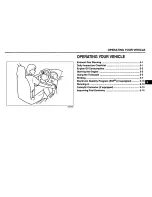
Chapter 6
Braking system
The design of the braking system is shown on fig. 6-1.
Fault diagnosis
Diagnosis
Remedy
Insufficient efficiency of braking
1. Leak of brake liquid from wheel
cylinders of front or rear brakes
2. Air in brake system
3. Damaged rubber sealings in
master brake cylinder
4. Damaged hydraulic system rub-
ber hoses
Spontaneous braking at working engine
1. Air inleak in servo unit between
valve housing and protective cap
Incomplete brake release on all wheels
1. No brake pedal free travel due
to wrong position of stop-signal
switch
2. Projection of servo unit adjusting
bolt in relation to fastening surface
of master cylinder exceeds 1.25
-0.2
mm
3. Jammed servo unit valve hous-
ing
4. Plugged compensation aperture
in master cylinder
5. Swollen master cylinder rubber
sealings due to penetration of
petrol, mineral oils and etc in liquid.
6. Jammed master cylinder piston
Snubbing of one wheel at released brake pedal
1. Loose or damaged return spring
of rare brake shoes
2. Jammed piston in wheel cylin-
der due to corrosion
3. Swollen wheel cylinder sealing
due to penetration of fuels and
lubricants in liquid
4. No gap between shoes and
drum
5. Wrong position of caliper in
relation to brake disc due to loose
bolts that are fastening carrier to
steering knuckle
6. Excessive runout of brake disc
(more than 0.15 mm)
Vehicle wandering or skidding at braking
1. Leak of brake liquid in one of
wheel cylinders
2. Jammed piston in brake wheel
cylinder
3. Clogged tube due to dent or
contamination
4. Different pressure in tyres
5. Wrong wheel alignment angles
6. Dirty or oily discs, drums and lin-
ings
7. Wrong adjustment of pressure
regulator
8. Faulty pressure regulator
Excessive pedal effort at braking
1. Plugged air filter
2. Jammed servo unit valve hous-
ing
3. Damaged hose between servo
unit and engine inlet pipe, or its
loose fastening on connectors
4. Oxidation of brake pedal metal
bushes or dry greasing in pedal
bushes
Scratch or squeal of brakes
1. Loose shoe return spring
2. Ovality of drums
3. Excessive oil on friction linings
4. Worn linings or trapped detri-
mental inclusions
5. Excessive disc runout or non-
uniform wear
Inspection and adjustment
Pipelines and connections - inspection
To prevent any occasional failure of the braking system care-
fully inspect all pipelines:
- metal pipelines should have no dents or cracks and should
lie far from sharp edges that can damage them;
- brake hoses should have no cracks on the outer surface and
should not get in contact with mineral oils and greasings that dis-
solve rubber; heavily depress the brake pedal and inspect the
hoses for bulges that will indicate malfunctions;
- all brake lines should be reliably fastened; loose fastening
will result in vibration causing damage;
- liquid leak through pipeline connections is not allowed; if
necessary, fully tighten the connections without deforming the
pipelines.
121
1. Renew bad components of
wheel cylinder, wash and dry
shoes and drums, bleed braking
mechanism
2. Expel air from system
3. Renew seals and bleed system
4. Renew hoses
1. Replace servo unit
1. Adjust switch position
2. Adjust bolt position (see fig. 6-2)
3. Replace servo unit
4. Clean aperture and bleed system
5. Carefully wash system with
brake liquid, renew damaged rub-
ber parts, bleed system
6. Check and replace, if necessary,
master cylinder, bleed system
1. Renew spring
2. Dismantle cylinder, clean and
wash all components, renew dam-
aged parts
3. Renew rings, wash system with
brake liquid
4. Adjust parking brake
5. Tighten securing bolts, renew
damaged parts if necessary
6. Grind disc, in case thickness is
less than 9 mm - renew
1. Renew air filter
2. Renew servo unit
3. Renew hose or tighten clips
4. Renew worn parts or greasing
1. Inspect return spring, replace if
necessary
2. Remachine brake drum
3. Clean pads using metal brush
with warm water and washing liq-
uid. Eliminate cause of liquid or
lubricate ingress
4. Renew pads
5. Grind disc, in case thickness is
less than 9 mm - renew
1. Renew seals and bleed system
2. Check and rectify piston sticking
in cylinder, renew damaged com-
ponents if necessary
3. Renew or clean tube, bleed sys-
tem
4. Adjust pressure
5. Adjust angles
6. Clean braking mechanism com-
ponents
7. Adjust position
8. Adjust or renew
Summary of Contents for Niva 4x4
Page 80: ...135 ...
Page 81: ...136 ...
















































